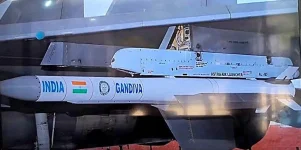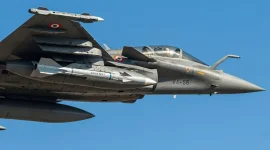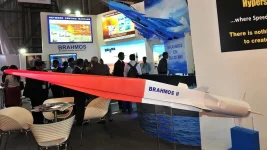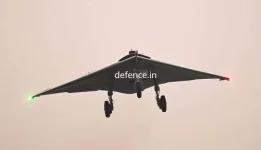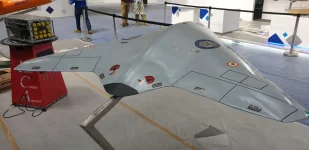- Views: 2K
- Replies: 14
India's Defence Research and Development Organisation (DRDO), the nation's primary agency for military research and development, has initiated a crucial phase in strengthening the country's aerial strike capabilities. Captive flight trials for the indigenously developed Tactical Advanced Range Augmentation (TARA) precision-guided bomb have begun, utilizing the Indian Air Force's (IAF) dependable Jaguar strike aircraft.
This development signifies a major step towards providing the IAF with a sophisticated weapon system capable of hitting targets deep within enemy territory with high accuracy, potentially keeping launch aircraft outside the range of hostile air defence systems. The trials, which started in February 2025, underscore India's advancing expertise in creating advanced munitions for modern warfare scenarios.
The TARA system represents a new family of glide bombs engineered by DRDO. Its purpose is to equip the IAF with versatile, long-range, and highly accurate weapons that are also cost-effective.
Designed for integration with various IAF aircraft, TARA will be produced in three different weight categories: 250 kg (TARA 250), 450 kg (TARA 450), and 500 kg (TARA 500). These variants cleverly utilize the casings of existing General Purpose (GP) and High-Speed Low Drag (HSLD) bombs previously developed by DRDO, which are already operational on key IAF fighters including the Jaguar, Mirage 2000, and the Sukhoi Su-30 MKI fleet. This approach leverages existing infrastructure and potentially simplifies logistics.
Distinguishing the TARA system are its sophisticated flight control and guidance mechanisms. The bomb features movable fins at its tail, allowing for precise aerodynamic control during flight. This enables the weapon to perform terminal manoeuvres and adjust its angle of approach, significantly boosting its ability to strike targets accurately, even when facing defensive measures.
Depending on the altitude and speed at which it is released, TARA can achieve speeds ranging from approximately 640 to 1,200 kilometres per hour, making it suitable for various mission profiles, from high-speed releases to more controlled glides towards a target.
TARA employs a multi-layered guidance strategy to ensure precision. For the mid-course phase of its flight, it relies on a combination of an Inertial Navigation System (INS) and GPS signals, achieving a commendable accuracy level measured by a Circular Error Probable (CEP) of less than 30 meters. CEP indicates the radius within which half of the munitions are expected to land. In the critical final moments before impact, a Semi-Active Laser (SAL) seeker takes over, drastically improving accuracy to a CEP of under 3 meters.
This level of precision is comparable to internationally recognized systems like the American Joint Direct Attack Munition (JDAM) family. The dual-mode guidance offers robustness, allowing accuracy even if GPS signals are jammed, while the laser guidance permits pinpoint strikes against specific, potentially moving, high-value targets.
A key advantage of the TARA system is its extended range, achieved through its aerodynamic design that allows it to glide significant distances after release, far exceeding conventional unguided bombs. While the exact operational range remains classified, similar international glide bomb systems can achieve standoff distances of 50 to 70 kilometres or more when launched from optimal altitudes. This standoff capability is crucial as it allows the launching aircraft to attack targets while remaining safely outside the engagement envelopes of many short- and medium-range enemy air defence systems.
Furthermore, TARA's ability to manoeuvre during its terminal phase increases its chances of overcoming point-defence systems protecting specific targets, making it effective against fortified structures like bunkers, command posts, and potentially even mobile targets.
The current captive flight trials are being conducted using the IAF's Jaguar aircraft, known as "Shamsher" (Sword) in Indian service. These trials, likely taking place over established test ranges such as Pokhran or Jaisalmer in Rajasthan, involve carrying inert TARA units (without explosives) under the aircraft's wings.
The primary goal is to rigorously evaluate the bomb's integration with the Jaguar's electronic systems (avionics), the physical release mechanisms, and its aerodynamic behaviour while attached to the aircraft. The Jaguar, a veteran deep-penetration strike aircraft valued for its low-level flight capabilities and payload capacity, serves as an excellent platform for testing such advanced weaponry.
During this phase, DRDO and IAF test pilots and engineers are meticulously assessing the TARA bomb's structural soundness under flight stresses, its aerodynamic effects on the aircraft, and its seamless communication with the Jaguar's systems, including its targeting pod – likely the Litening pod commonly used by the IAF for laser designation.
Successfully completing these captive trials is a prerequisite for progressing to the next stage: live drop tests. These future tests will involve releasing active TARA bombs to validate the performance of the guidance systems and confirm the weapon's exceptional terminal accuracy against real-world or simulated targets.
The Jaguar fleet itself has undergone significant upgrades, including the DARIN III navigation and attack system, enhancing its capacity to operate sophisticated munitions like TARA.
The inherent modularity of the TARA design allows for mission flexibility. The lighter TARA 250 is suited for precise attacks on smaller or softer targets, such as vehicle convoys or enemy radar sites. The heavier TARA 450 and TARA 500 variants deliver considerably more destructive power, making them ideal for neutralizing larger, hardened targets like strategic bridges or underground command facilities.
The utilization of standard GP bomb bodies ensures compatibility with existing IAF ordnance stockpiles, while the option of using HSLD bodies offers advantages in terms of reduced air resistance, potentially leading to greater range and better penetration against certain target types.
The successful development and induction of TARA will significantly enhance the IAF's offensive capabilities.

